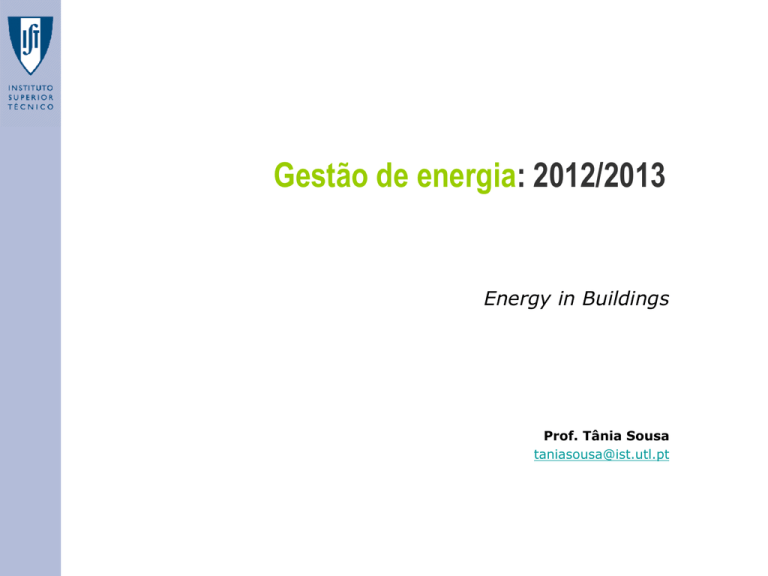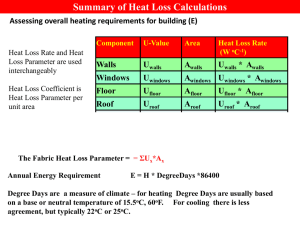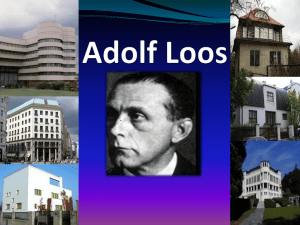Buildings
advertisement

Gestão de energia: 2012/2013 Energy in Buildings Prof. Tânia Sousa taniasousa@ist.utl.pt Gestão de Energia Energy Consumption in Buildings • Buildings account for 40% of total energy consumption in the European union • What about Portugal? – In 2010 the final consumption of services + domestic sector represented 55% of the final energy consumption – Do you think that the fraction of primary energy would be higher or lower? Why? Slide 2 of 53 Gestão de Energia Energy Consumption in Buildings • Most effective strategy to reduce energy use in buildings (Harvey, 2010): – Reduce heating and cooling loads through a highperformance envelope • high degree of insulation, windows with low U values in cold climates and low solar heat gain in hot climates, external shading and low air leakage – Meet the reduced load as much as possible using passive solar heating, ventilation and cooling techniques while optimizing the use of daylight – Use the most efficient mechanical equipment to meet the remaining loads – Ensure that individual energy-using devices are as efficient as possible and properly sized Slide 3 of 53 Gestão de Energia Energy Consumption in Buildings • How much energy reduction can we achieve? – Passive house standard: heating 15kWh/m2 per year cooling 15 kWh/m2 per year TPE 120 kWh/m2 per year n50 ≤ 0.6 / hour From 220 kWh/m2/year to 20-40 kWh/m2/year Triple-glazed windows with internal venetian blinds & mechanical ventilation with 82% heat recovery Slide 4 of 53 Gestão de Energia Energy Consumption in Buildings • How much does it cost? 1991 Prototype: experimental house, 4 dwellings in Kranichstein using handicraft batch production 300 PH in Groß-Umstadt: Reduced costs by simplification 250 200 Row houses in Darmstadt, 80 €/m2 150 Settlement in Wiesbaden: Serially produced windows & structural elements 100 Settlements in Wuppertal, Stuttgart, Hanover 50 Profitability with contemporary interest rates & energy prices 2010 2009 2008 2007 2006 2005 2004 2003 2002 2001 2000 1999 1998 1997 1996 1995 1994 1993 1992 1991 0 1990 Additional Investment (€/m2) of Passive Row Houses 350 Slide 5 of 53 Gestão de Energia Buildings – High Performance Envelope • The effectiveness of the thermal envelope depends of insulation levels in the walls, ceiling and basement – Insulation levels control the heat flow by conduction & convection through the exterior and the interior Q U T Area – U value (W/m2/K), the heat trasnfer coefficient, is equal to the heat flow per unit area and per degree of inside to outside temperature difference – The U value of a layer of insulation depends on its length and type of material U C l Slide 6 of 53 Gestão de Energia Buildings – High Performance Envelope • The effectiveness of the thermal envelope depends of insulation levels in the walls, ceiling and basement Q U T Area U C l The most highly insulated houses have U=0.1-0.2 W/m2/K Blown-in cellulose insulation (fills the gaps) Foam insulation Vaccum insulation panels Slide 7 of 53 Gestão de Energia Buildings – High Performance Envelope • The effectiveness of the thermal envelope depends on the insulation levels of windows – Windows offer substantially less resistance to the loss of heat than insulated walls – Single glazed windows have a typical U-value of 5W/m2/K which can be reduced to to 2.5 and 1.65W/m2/K with double and triple glazing because of the additional layers of air – The U-value of 2.5W/m2/K of double glazed windows can be reduced to 2.4W/m2/K and 2.3W/m2/K with Argon and krypton – Double and triple glazing vaccum windows can reduce the U value to 1.2 and 0.2W/m2/K Q U T Area U C l Slide 8 of 53 Gestão de Energia Buildings – High Performance Envelope • The effectiveness of the thermal envelope depends on the gain/loss energy by radiation – Windows permit solar energy to enter and loss of infrared radiation – Low emissivity coatings reflect more (reduce SHGC), i.e., reduce heat gains in summer and winter – Low emissivity coatings can reduce loss of heat by infrared radiation – The solar heat gain coefficient, SHGC, is the fraction of solar radiation inicident on a window that passes through the window Slide 9 of 53 Gestão de Energia Buildings – High Performance Envelope • The effectiveness of the thermal envelope depends on the air leakage – The net heat flow due to an air exchange at rate r is: Q air c p,air Vair T – The stack effect promotes air leakage • Cold air is sucked into the lower part and warm air exits through the upper part through craks and openings because it is lighter. • Stack effect can account for up to 40% of heating requirements on cold climates – The wind effect Slide 10 of 53 Gestão de Energia Buildings – High Performance Envelope • The effectiveness of the thermal envelope depends on the air leakage – Careful application of a continuous air barrier can reduces rates of air leakage by a factor of 5 to 10 compared to standard practice (enforcement of careful workmanship during construction) – Buildings with very low air leakage require mechanical ventilation (95% of the available heat in the warm exhaust air can be transfered to the incoming cold air) to keep indoor air quality Slide 11 of 53 Energy Balance in Open Systems • Heat Exchangers: – Used in power plants, air conditioners, fridges, liquefication of natural gas, etc – Transfer energy between fluids at different temperatures v j2 vi 2 dE Q W min ,i hi gzi mout , j h j gz j dt 2 2 i j Direct Contact Heat Exchanger Counter-flow Heat exchanger Direct Flow Heat Exchanger Gestão de Energia Buildings – The role of shape, form, orientation and glazed % • Building shape & form – Have significant impacts on heating and cooling loads and daylight because of the relation between surface area and volume – Which one minimizes heat transfer by conduction and convection? • Building orientation – For rectangular buildings the optimal orientation is with the long axis facing south – Why? Slide 13 of 53 Gestão de Energia Buildings – The role of shape, form, orientation and glazed % • Glazing fractions – High glazing fractions increase energy requirements for heating and cooling – There is little additional daylighting benefit once the glazed fraction increases beyond 30-50% of the total façade area Energy Intensity (kWh/m2/yr) 200 180 160 140 120 100 80 60 40 20 0 30% Base Heating Equipment 60% Base • House size 60% Upgraded Cooling Pumps & fans 100% Base 100% Upgraded Lighting Server rooms – The living area per family member increased by a factor of 3 between 1950 and 2000 in the US Slide 14 of 53 Gestão de Energia Buildings – (almost) Passive solar heating, ventilation & cooling • Evaporative Cooling: Slide 15 of 53 Gestão de Energia Buildings – Passive (almost) solar heating, ventilation & cooling • Thermal induced ventilation & cooling: Earth Pipe cooling Large Atria Slide 16 of 53 Gestão de Energia Buildings – Passive (almost) solar heating, ventilation & cooling • Wind induced ventilation & cooling: Wind catcher Slide 17 of 53 Gestão de Energia Buildings – Passive (almost) solar heating, ventilation & cooling • Passive Solar Heating & Lighting Shading Light tubes Light shelves Slide 18 of 53 Gestão de Energia Buildings: Mechanical Equipment • In evaluating the energy efficiency of Mechanical Equipment the overall efficiency from primary to useful energy should be taken into account • This is particularly important in the case of using Mechanical Equipments that use electricity (produced from fossil fuels) E final E primary Euseful E final Slide 19 of 53 Gestão de Energia Buildings: Mechanical Equipment for heating • Furnaces – heat air and distribute the heated air through the house using ducts; – are electric, gas-fired (including propane or natural gas), or oil-fired. – Efficiencies range from 60 to 92% (highest for condensing furnaces) • Boilers – heat water, and provide either hot water or steam for heating; – heat is produced from the combustion of such fuels as natural gas, fuel oil, coal or pellets. – Efficiencies range from 75% to 95% (highest for condensing boilers) Slide 20 of 53 Gestão de Energia Buildings: Mechanical Equipment for heating & cooling • Electrical-resistance heating – Overall efficiency can be quite low (primary -> useful) • Heat-Pumps – – – – Overall efficiency can be quite good It decreases with T Air-source and ground-source For cooling & heating • District Heating/Colling – For heating & cooling – Users don’t need mechanical equipment Slide 21 of 53 Gestão de Energia Buildings: Mechanical Equipment for cooling • Chillers – Produce cold water which is circulated through the building – Electric Chillers: use electricity – Absorption chillers: use heat (can be waste heat from cogeneration) – Electric chillers, COP = 4.0-7.5 (larger units have a higher COP) – Absorption chillers, COP = 0.6-1.2 Slide 22 of 53 Gestão de Energia Buildings: HVAC Systems • Ventilate and heat or cool big buildings • All air systems: air at a sufficient low (high) T and in sufficient volumes is circulated through the building to remove (add) heat loads – CAV: constant air volumes – VAV: variable air volumes – Air that is circulated in the supply ducts may be taken entirely from the outside and exhausted to the outside by the return ducts or a portion of the return air may be mixed with fresh air – Incoming air needs to be cooled and dehumidified in summer and heated and (sometimes) humidified in winter • Restrict air flow to ventilation needs and use additional systems for additional heating/cooling • Heat exchangers that transfer heat between outgoing and incoming air flows Slide 23 of 53 Gestão de Energia Buildings: Mechanical Equipment for water heating • Electrical and natural gas heaters – – – – Efficiency of natural gas heaters is 76-85% Efficiency of oil heaters is 75-83% There is heat loss from storage tanks Point-of-use tankless heaters have losses associated with the pilot light • There are systems that recover heat from the warm wastewater with 45-65 % efficiencies Slide 24 of 53 Gestão de Energia European Directives • European Directives on the Energy Performance of Buildings – Directive 2002/91/EC of the European Parliament and Council (on the energy performance of buildings): – http://ec.europa.eu/avservices/video/videoplayer.cfm?r ef=I048425&videolang=en&sitelang=en – This is implemented by the Portuguese Legislation RCCTE and RCESE – Directive 2010/31/EU of the European Parliament and Council (on the energy performance of buildings) Slide 25 of 53 Gestão de Energia Directive 2010/31/EU: Aims • • • • • • • Reduction of energy consumption Use of energy from renewable sources Reduce greenhouse gas emissions Reduce energy dependence Promote security of energy supplies Promote technological developments Create opportunities for employment & regional development • Links with aims of SGCIE? Slide 26 of 53 Gestão de Energia Directive 2010/31/EU: Principles • The establishment of a common methodology to compute Energy Performace – including thermal characteristics, heating and air conditioning instalations, renewable energies, passive heating and cooling, shading, natural light and design Slide 27 of 53 Gestão de Energia Directive 2010/31/EU: Principles • Set Minimum Energy Performance Requirements – Requirements should take into account climatic and local conditions and cost-effectiveness Slide 28 of 53 Gestão de Energia Directive 2010/31/EU: Principles • Energy Performance Requirements should be applied to new buildings & buildings going through major renovations Slide 29 of 53 Gestão de Energia Directive 2010/31/EU: Principles • Set System Requirements for: energy performance, appropriate dimensioning, control and adjustment for Technical Building Systems in existing and new buiildings Slide 30 of 53 Gestão de Energia Directive 2010/31/EU: Principles • Increase the number of nearly zero energy buildings Slide 31 of 53 Gestão de Energia Directive 2010/31/EU: Principles • Establish a system of Energy performace certificates. – Energy Performance certificates must be issued for constructed, sold or rented to new tenants – Buildings occupied by public authorities should set na example (ECO.AP in 300 public buildings in Portugal) Slide 32 of 53 Gestão de Energia Directive 2010/31/EU: Principles • Regular maintenance of air conditioning and heating systems • Independent experts Slide 33 of 53 Gestão de Energia Implementation of the directives • Directive 2002/91/EC was implemented with: 1. DL 78/2006, the National Energy Certification and Indoor Air Quality in Buildings (SCE). 2. DL 79/2006, Regulation of HVAC Systems of Buildings (RSECE). 3. DL 80/2006, Regulation of the Characteristics of Thermal Performance of Buildings (RCCTE). • Directive 2010/31/EU was not yet implemented Slide 34 of 53 Gestão de Energia RCCTE – Aim RCCTE - Aims • General aims: – Methodology for computing energy performace of buildings – Set minimum energy performance standards – Implement Energy Certification of buildings • Specific Aims: – Limitation of annual energy needs for heating, cooling, domestic hot water and primary energy – Limitation of heat transfer coefficients – Limiting of solar factors – Installation of solar panels Slide 35 of 53 Gestão de Energia – Domain of application RCCTE – RCCTE Domain of Application • Buildings that RCCTE applies to: Residential Comercial Small New Old Major Renovation No Renovation Pnom < 25 kW RCCTE RCCTE Pnom > 25 kW Pnom < 25 kW RCCTE RCCTE Big Pnom > 25 kW Pnom < 25 kW Pnom > 25 kW Slide 36 of 53 Gestão de Energia - Outdoor conditions RCCTE – Indoor &RCCTE Outdoor Conditions Reference Indoor conditions • 20ºC in heating season • 25ºC and 50% relative humidity in the cooling season • Consumption of 40 liters of water at 60ºC/occupant . day Reference Outdoor conditions: • Portugal is divided in winter and summer climatic zones Slide 37 of 53 Gestão de Energia - Outdoor conditions RCCTE –RCCTE Outdoor Conditions Reference Outdoor conditions: Slide 38 of 53 Gestão de Energia RCCTE – Outdoor Conditions Climate • Heating Degree-days are: GDannual Heating days GD i 1 i where GDi 24 Tb T j j 1;se Tb T j 24 • Where: • Tb is the desired indoor temperature (20ºC) • Tj is the temperature outside the hours j • The Degree-days are calculated for an entire year • For example, to Lisbon, for Tb = 20 º C, heating degree days are 1190 º C.day. Knowing the heating season is 6 months (180 days), the average daily GD (GDI) will be 6.6 º C. Slide 39 of 53 Gestão de Energia Heating Degree Days – a comparison 5000 4000 3000 2000 1000 i H el si nk a nn Vi e er B ou Va nc lin r ve to ro n To ni pe g in W m on t on 0 Ed Heating Degree Days (K-days) 6000 Slide 40 of 53 Gestão de Energia RCCTE – Outdoor Conditions Climate • Outdoor project temperature • The outside project temperature is calculated on a cumulative probability of occurrence of 99%, 97.5%, 95% and 90%. • A cumulative probability of occurrence of 99% means that in summer the temperature indicated is exceeded only in probabilistic terms, 1% of the time, ie, 30 hours per year (e.g. Lisbon). Probabilidade Acumulada de Ocorrência Temperatura de Projecto (ºC) 90% 27 95% 29.4 97.5% 31.4 99% 33.3 Slide 41 of 53 Gestão de Energia RCCTE –thermal Indices e parameters RCCTE – Fundamental Indices • The thermal behavior of buildings is characterized using the following fundamental thermal indices: Nic Nominal Annual Needs of Useful Energy for Heating Ni The corresponding maximum permissible Nvc Nv Nominal Annual Needs of Useful Energy for Cooling Nac Nominal Annual Energy needs for Domestic Hot Water Na The corresponding maximum permissible Ntc Nominal Annual Energy needs for Primary Energy Nt The corresponding maximum permissible The corresponding maximum permissible Nic ≤ Ni Nvc ≤ Nv Nac ≤ Na Ntc ≤ Nt Slide 42 of 53 Gestão de Energia – Indicesparameters e parameters RCCTE – RCCTE Additional • The thermal behavior of buildings is characterized using the parameters: more demanding for harsher winters more demanding for harsher summers Additional parameters U Umax Heat transfer coefficients of walls The corresponding maximum permissible Heat Transfer Coefficients of Thermal Bridges 2 x Umax Fs Fsmax Solar factor of fenestration (for windows not facing NE-NW with area > 5%) The corresponding maximum permissible Slide 43 of 53 Gestão de Energia Heating RCCTE – Fundamental thermal Indices: Heating FF ≤ 0.5 :: Ni = 4,5 + 0,0395 GD 0,5 < FF ≤ 1 :: Ni = 4,5 + (0,021+ 0,037FF) GD 1 < FF ≤ 1,5 :: Ni = [4,5 +(0,021+ 0,037FF) GD] (1,2 – 0,2 FF) FF > 1,5 Ni [kWh/m2.ano] Heating: Maximum Allowable Needs (Ni) [kWh / (m2.year)] :: Ni = 4,05 + 0,06885 GD 0 Form factor: FF = ( (Aext) + ( Aint))/V GD :: Degree day (ºC * day) 0.5 1 1.5 2 FF [-] more demanding for smaller FF Nic < Ni Heating: Nominal Needs (Nic) [kWh / (m2.year)] Nic = (Qt + Qv – Qgu) / Ap Qt = 0.024 x GD x (A x U) to keep the Tint = 20ºC during the heating season Qv = 0,024 (0,34 x R x Ap x Pd) x GD Qt: heat loss by conduction & convection through the surrounding Qv: heat losses resulting from air exchange Qgu: solar gain and internal load Slide 44 of 53 Gestão de Energia Current average residential heating energy use (Harvey, 2010) • 60-100 kWh/m2/yr for new residential buildings in Switzerland and Germany • 220 kWh/m2/yr average of existing buildings in Germany • 250-400 kWh/m2/yr for existing buildings in central and eastern Europe • For Lisbon the maximum heating allowable needs are: Ni ( FF Ni ( FF Ni ( FF Ni ( FF 0.5) 51.5kWh / m2 / yr 0.75) 62.5 kWh / m2 / yr 1.25) 80.3 kWh / m2 / yr 1.5) 86 kWh / m2 / yr • Passive house standard: 15 kWh/m2/yr Slide 45 of 53 Gestão de Energia RCCTE – Fundamental thermal Indices: Cooling Cooling Cooling: Maximum Allowable Needs (Nv) [kWh/(m2.year)] V1 (North) : Nv = 16 V2 (North) : Nv = 18 V3 (North) : Nv = 26 Açores : Nv = 21 V1 (South) : Nv = 22 V2 (South) : Nv = 32 V3 (South) : Nv = 32 Madeira : Nv = 23 Cooling: Nominal Needs (Nvc) [kWh / (m2.year)] Nvc = Qg * (1 - ) / Ap (kWh/m2year) Qg : Total gross load (internal + walls + solar + air renewal) : Load Factor Nvc < Nv to keep the Tint = 25ºC during the cooling season Slide 46 of 53 Gestão de Energia Domestic Water RCCTE – Fundamental thermal Indices: HotHot Water Domestic Hot Water: Maximum Allowable Needs (Na) [kWh / (m2.year)] Na = 0,081 MAQS nd/Ap MAQS : Reference consumption (40 liters per occupant) 1 m2 solar panel collector per occupant or 50% of available area if solar exposition is adequate nd : Reference n. of days with DHW (residential:365) N. of occupants: T0=2; TN=n+1 Domestic Hot Water: Nominal Needs (Nac) [kWh / (m2.year)] Nac = (Qa/ηa – Esolar – Eren)/Ap Qa: Conventional useful energy requirements ηa: Efficiency of the conventional systems ESolar: Contribution of solar thermal panels for DHW Eren: Contribution to other renewable for DHW Nac < Na Qa : (MAQS * 4187 * T * nd) / (3 600 000) (kWh/year) Maqs = 40 l /occupant . Day*nº occupants T : 45º (15ºc 60ºc) Slide 47 of 53 Gestão de Energia Primary energy RCCTE – Fundamental thermal Indices: Primary Energy Primary energy: Maximum Allowable Needs (Nt) [kgep/(m2.year)] Nt = 0,9 (0,01Ni + 0,01 Nv + 0,15 Na) Primary energy : Nominal Needs (Ntc) [kgep/(m2.year)] Ntc = 0,1 (Nic/ηi)Fpui + 0,1 (Nvc/ηv)Fpuv + Nac Fpua Fpu : Conversion factor from final energy to primary energy Electricity: Fpu = 0.290 kgep / kWh Ntc < Nt Fuels: Fpu = 0.086 kgep / kWh In the absence of more precise data consider, eg: Electrical resistance = 1 Boiler fuel gas = 0.87 Heat Pump = 3 (cooling) and 4 (heating) Slide 48 of 53 Gestão de Energia Energy label Energy Performance Certificate • Energy Labelling: R = Ntc / Nt R A 1 B- A+ B New buildings (licensed after 2006) C 2 D E 3 Old buildings F G Slide 49 of 53 Gestão de Energia RCCTE – Aim RCESE - Aims • General aims: – Methodology for computing energy performace of buildings – Set minimum energy performance standards – Implement Energy Certification of buildings – Regular inspection of boilers and air conditioning in buildings • Specific Aims: – Limitation of annual energy needs for heating, cooling, and primary energy – Limitation of heat transfer coefficients – Limiting of solar factors – Maintenance of HVAC systems – Monitoring and energy audits Slide 50 of 53 Gestão de Energia Structure RCESE – Domain of Application • Buildings that RCESE applies to: Residential Comercial Small New Old Major Renovation No Renovation Pnom < 25 kW RCCTE RCCTE Pnom > 25 kW RSECE RSECE Pnom < 25 kW RCCTE RCCTE Big Pnom > 25 kW RSECE RSECE Pnom < 25 kW RSECE RSECE Pnom > 25 kW RSECE RSECE RSECE RSECE Slide 51 of 53 Gestão de Energia - Outdoor conditions RCESE – Indoor &RSECE Outdoor Conditions Indoor conditions • the same of RCCTE • air velocity can not exceed 0,2 m/s •QAI (minimum air renovation and maximum concentration of air polutants) Reference Outdoor conditions: • Portugal is divided in winter and summer climatic zones Slide 52 of 53 Gestão de Energia IEE RCESE - IEE Methodology to compute Energy Performance IEE : Energy Efficiency Indicator (kgep/(m2.year)] IEE = IEEi + IEEv + Qout/Ap Heating Cooling This value must be less than the tabled IEE to the proposed activity Other consumptions IEEi = (Qaq / Ap) x Fci Qaq : primary energy consumption for heating (kgep/year) IEEv = (Qarr / Ap) x Fcv Qarr : primary energy consumption for cooling (kgep/year) Fci : Correction factor for heating, Fci = Ni1/Nii Fcv : Correction factor for cooling, Fcv = Nv1/Nvi Renewable energies are not included Real energy consumptions (old) or simulation (new) Slide 53 of 53 Gestão de Energia Correction Factors Slide 54 of 53 Gestão de Energia Heating RCESE – Fundamental thermal Indices: Heating & Cooling Heating: Maximum Allowable Needs (Ni) [kWh / (m2.year)] :: Ni = 4,5 + 0,0395 GD 0,5 < FF ≤ 1 :: Ni = 4,5 + (0,021+ 0,037FF) GD 1 < FF ≤ 1,5 :: Ni = [4,5 +(0,021+ 0,037FF) GD] (1,2 – 0,2 FF) FF > 1,5 :: Ni = 4,05 + 0,06885 GD Form factor: FF = ( (Aext) + ( Aint))/V Ni [kWh/m2.ano] FF ≤ 0.5 0 GD :: Degree day (ºC * day) 0.5 1 1.5 2 FF [-] GD=1000 degree days Cooling: Maximum Allowable Needs (Nv) [kWh/(m2.year)] V1 (North) : Nv = 16 V2 (North) : Nv = 18 V3 (North) : Nv = 26 Açores : Nv = 21 V1 (South) : Nv = 22 V2 (South) : Nv = 32 V3 (South) : Nv = 32 Madeira : Nv = 23 Slide 55 of 53 Gestão de Energia Structure RCESE – Minimum Energy Performance • Minimum Energy Performance Requirements: Residential New Old Major Renovation Pnom < 25 kW RCCTE RCCTE Pnom > 25 kW Nic ≤ 80%Ni,RCCTE Nvc ≤ 80%Nv,RCCTE Comercial Pnom < 25 kW RCCTE RCCTE Small Pnom > 25 kW Nic ≤ 80%Ni,RCCTE Big Pnom < 25 kW Pnom > 25 kW IEE ≤ IEEmax Nvc ≤ 80%Nv,RCCTE IEE ≤ IEEmax No Renovation – If the minimum energy performance requirements of old big comercial buildings are not met than there is na energy audit to develop an energy rationalization plan and all efficiency measures with economic viability have to be implemented Slide 56 of 53 Gestão de Energia IEE tabled values for existing buildings Slide 57 of 53 Gestão de Energia IEE IEE tabled values for new buildings or major renovations Slide 58 of 53 Gestão de Energia label Energy Performance Energy Indicator • Energy Labeling: – Depends on IEEnom, on IEEREF and on the S parameter Slide 59 of 53 Gestão de Energia label Energy Performance Energy Indicator • Energy Labeling: Old buildings IEE (kgep/year. m2) New buildings S (licensed > 2006) IEEref S A+ A B B- C D E F G Slide 60 of 53 Gestão de Energia System Requirements for HVAC • Limit the installed power: – Heating or cooling PNOM < 1.4 of the power needed • Promote Energy Efficiency – If PNOM> 100 kW than HVAC system with centralized heat production – The connection to centralized heating and cooling systems (if available) is mandatory – The heating power obtained by Joule effect cannot exceed 5% of the heating thermal power • Control and regulation systems – Control confort temperatures – Turn off when the space is not used • Monitoring (PNOM> 100 kW ) and Energy Management Systems (PNOM> 200 kW ) with centralized optimization (PNOM> 250 kW ) • Audits to big boilers and AC Slide 61 of 53 Gestão de Energia Differences between Directives 2002/91/EC and 2010/31/EU • 2010/31/EU has requirements on increasing the number of nearly zero-energy buildings; • 2010/31/EU has requirements on the minimum energy performance of all (not only on big) existing buildings subject to major renovations • In 2010/31/EU the framework for energy performance: – Based on the computed or actual annual energy consumed in order to meet different needs associated with typical behavior – Energy performance indicator and a numerical indicator of primary energy consumption Slide 62 of 53 Gestão de Energia Differences between Directives 2002/91/EC and 2010/31/EU • 2010/31/EU sets the minimum energy performance requirements targeting cost-optimal levels (to be calculated in accordance with a comparative methodology framework). • 2010/31/EU considers that the methodology for the identification of cost-optimal levels should : – take into account use patterns, outdoor climate conditions, investment costs and maintenance and operating costs; – be computed for reference buildings with different functionalities and geographic locations; – define the efficiency measures that should be assessed; – consider the expected economic life-cycle of the building; Slide 63 of 53 Gestão de Energia Differences between Directives 2002/91/EC and 2010/31/EU • 2010/31/EU considers that the technical, environmental and economic feasibility of highefficiency alternative systems such as (decentralized energy supply systems based on energy from renewable sources, cogeneration, district or block heating or cooling, heat pumps) should be considered for all (not only > 1000 m2) new buildings • 2010/31/EU considers that when all buildings (not only > 1000 m2) undergo major renovation, the energy performance of the building or the renovated part thereof is upgraded in order to meet minimum energy performance requirements Slide 64 of 53







